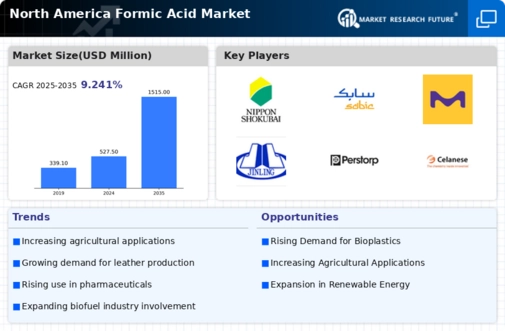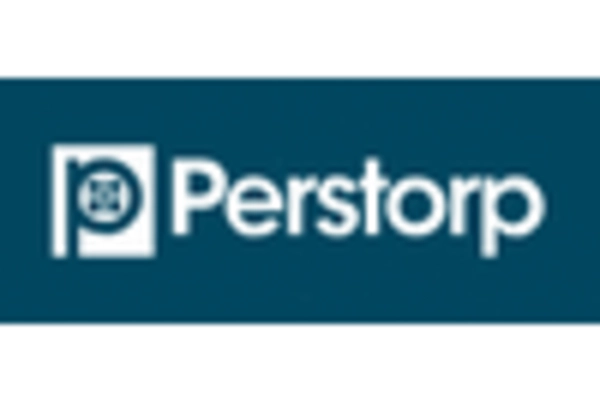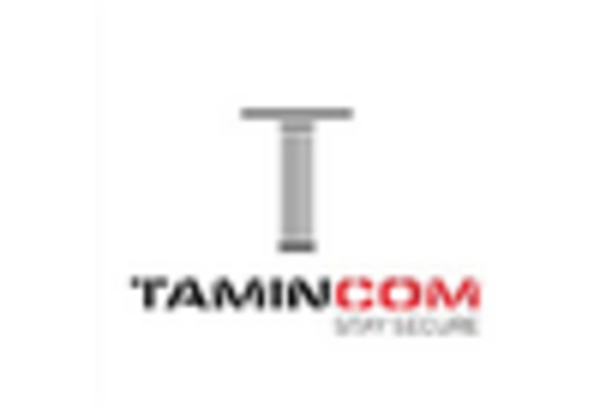Growth in Animal Feed Applications
The formic acid market is experiencing notable growth due to its increasing application in animal feed. Formic acid serves as a preservative and acidifier, enhancing the nutritional value of feed while preventing spoilage. In North America, the livestock sector is projected to expand, with a focus on improving feed efficiency and animal health. This trend is likely to drive demand for formic acid, as it is recognized for its ability to reduce pathogenic bacteria in feed. The market for animal feed additives is expected to grow at a CAGR of approximately 5% over the next few years, further bolstering the formic acid market. As livestock producers seek cost-effective solutions to enhance productivity, the utilization of formic acid in feed formulations appears to be a strategic choice.
Rising Demand in Chemical Synthesis
The formic acid market is poised for growth due to its essential role in chemical synthesis. Formic acid is a key intermediate in the production of various chemicals, including pharmaceuticals and agrochemicals. In North America, the chemical manufacturing sector is expanding, with a focus on developing innovative products. The market for specialty chemicals is expected to grow at a CAGR of approximately 6% in the coming years, which may lead to increased demand for formic acid as a building block in chemical processes. Additionally, the versatility of formic acid in producing esters and other derivatives positions it as a valuable component in the formulation of diverse chemical products. This trend suggests a robust future for the formic acid market as it aligns with the evolving needs of the chemical sector.
Increasing Use in Leather Processing
The formic acid market is significantly influenced by its application in leather processing. Formic acid is utilized in the tanning process, where it aids in the preservation and quality enhancement of leather products. In North America, the leather industry is witnessing a resurgence, driven by consumer demand for high-quality leather goods. The market for leather products is anticipated to grow, with a projected increase of around 4% annually. This growth is likely to stimulate the demand for formic acid, as manufacturers seek effective tanning agents that ensure durability and aesthetic appeal. Furthermore, the shift towards sustainable practices in leather production may enhance the attractiveness of formic acid, given its relatively lower environmental impact compared to traditional tanning agents.
Advancements in Renewable Energy Technologies
The formic acid market is likely to benefit from advancements in renewable energy technologies. Formic acid is being explored as a potential energy carrier, particularly in hydrogen storage and fuel cell applications. In North America, the push towards sustainable energy solutions is gaining momentum, with investments in research and development of alternative energy sources. The market for hydrogen fuel cells is projected to grow significantly, potentially increasing the demand for formic acid as a safe and efficient means of hydrogen storage. This innovative application could open new avenues for the formic acid market, aligning with the broader trends of decarbonization and energy transition. As the renewable energy landscape evolves, the role of formic acid may become increasingly prominent.
Regulatory Trends Favoring Biodegradable Chemicals
The formic acid market is influenced by regulatory trends that favor biodegradable chemicals. As environmental concerns rise, North American regulations are increasingly promoting the use of eco-friendly substances in various applications. Formic acid, being biodegradable and less harmful to the environment, is gaining traction in sectors such as agriculture and textiles. The market for biodegradable chemicals is expected to grow at a CAGR of around 7%, driven by consumer preferences for sustainable products. This regulatory support may enhance the competitiveness of formic acid, encouraging manufacturers to adopt it in their formulations. As companies strive to comply with stringent environmental regulations, the formic acid market appears well-positioned to capitalize on this shift towards sustainability.

















Leave a Comment